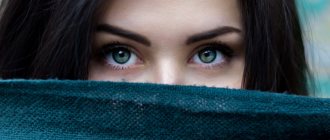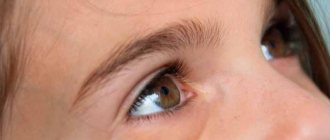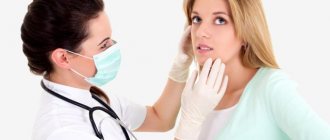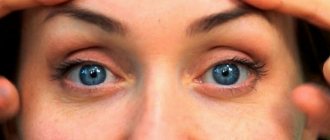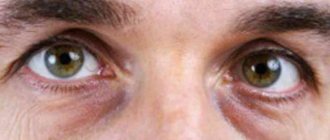A pimple under the eye is a fairly common occurrence that occurs in people of both sexes at any age. A cosmetic defect may be the result of improper skin care, or it may be a sign of disorders in the body.
It is important to distinguish a pimple (acne, acne) from skin tumors. Acne usually takes the form of comedones (white or blackheads), papules (reddish bumps), pustules (nodules containing pus), or nodules (large, inflamed areas).
Pimples under the eyes cause a person not only psychological, but also physiological discomfort: they can hurt, itch, increase in size, cause swelling and lacrimation. Purulent pimples on the eyelids and mucous membranes pose a potential threat to the organs of vision and the entire body. Therefore, if the education does not go away on its own, you should not delay going to the doctor.
Types of formations under the eyes
The main types of skin defects are on the mucous membrane of the eyes and on the eyelids.
- Barley is a purulent formation that occurs as a result of infection of the hair follicle of the eyelash. Externally it manifests itself as severe redness, swelling and soreness of the edge of the eyelid. The causative agent of the disease is most often Staphylococcus aureus. The ICD-10 code is H00.
- Xanthelasma is a single or multiple painless yellowish formation in the form of a flat plaque. Most often it is located on the upper eyelid at the inner corner of the eye. The ICD-10 code is H02.6.
- Chalazion is a chronic inflammatory compaction in the form of a nodule located in the thickness of the eyelid. Develops against the background of blockage and infection of the meibomian gland. The ICD-10 code is H00.1.
- Milium is a small, painless, white cystic formation at the mouth of the hair follicle containing sebum. Often found in newborns. The ICD-10 code is L72.0.
Video: What is milium (millet) and how to treat it.
- Lipoma (wen, fatty tumor) is a benign, painless soft tumor consisting of adipose tissue. Localized in the subcutaneous tissue. The ICD-10 code is D17.
- Furuncle (boil) is an acute purulent-necrotic lesion of the sebaceous gland, hair follicle and surrounding tissues. The causative agent of infection is most often Staphylococcus aureus. The ICD-10 code is L02.
- A pinguecula is a yellow-white formation on the conjunctiva of the eye. Depending on the size, it may be asymptomatic, or may cause a feeling of dryness and a foreign body, and eye hyperemia. The ICD-10 code is H11.1.
- Pimples (acne, blackheads) are an inflammatory skin disease caused by blockage of the sebaceous glands.
Acne tends to progress with increasing severity of symptoms : sebaceous plugs (comedones) are accompanied by an infection caused by propionbacteria acne or coccal flora. Papules (nodules without purulent contents) are formed, then pustules (purulent sacs) and nodes (fusion of pustules).
There are 4 forms of acne:
- comedonal - open and closed comedones are observed in large numbers on the skin without signs of inflammation;
- papulopustular form - characterized by the presence of comedones and papules, pustules are present sporadically;
- nodular form - predominantly pustular rash, open or closed comedones may be observed;
- severe form - extensive red-bluish inflamed areas of skin formed as a result of the fusion of pustules.
Acne severity:
- mild – the total number of rash elements is no more than 30: mostly open and closed comedones, papules and pustules are present sporadically;
- medium – the total number of rash elements is no more than 120: comedones and papules predominate, pustules are rare;
- severe - rashes exceed 120 units: papules and pustules predominate, drainage nodes may be observed;
- extremely severe - a very large number of papules and pustules, as well as extensive cyanotic nodes.
The acne code according to ICD-10 is L70.0.
Causes of acne on the eyes
Pimples near the eyes can differ in structure and size. Some of them are formed as a result of blockage of the sebaceous ducts, some as a result of infection, and some may result from improper functioning of internal organs.
We also have an article about signs if you have a pimple on your eye.
Pimples around the eyes
Small reddish pimples around the eyes can occur as a result of an allergic reaction to certain cosmetics, food irritants or medications.
Single or multiple reddish bumps on both eyelids are a papular or pustular rash formed due to the addition of a bacterial infection to the blockage of the sebaceous glands.
Wen (small white “grains” around the eyes) occur due to metabolic or hormonal disorders in the body.
Pimple on the eye on the upper eyelid
A large protruding pimple on the upper eyelid of a yellowish color is xanthelasma , which forms against the background of impaired fat metabolism in the body.
Often, such skin defects are diagnosed in people suffering from obesity, type 2 diabetes, pancreatitis, and high blood cholesterol.
Styes may also be localized on the upper eyelid . The reason for the formation of barley is a temporary decrease in immunity after suffering from colds, as well as endocrine disorders and diseases of the digestive system.
On the lower eyelid
Styes can “jump up” on both the upper and lower eyelids. This red, painful lump limits the mobility of the eyelids, thereby causing severe discomfort to the person.
Chalazion , which is also often localized on the edge of the lower eyelid, differs from stye in its chronic course and less pain. The causes of chalazion are non-compliance with personal hygiene rules, chronic diseases of the gastrointestinal tract, and metabolic disorders in the body.
White pimple on the eyelid
White pimples can appear on both the upper and lower eyelids. As a rule, these are painless formations - closed comedones, lipomas (fat) or milia.
There are many reasons for the occurrence of such defects : insufficient cleansing of the face from sebum, lipid metabolism disorders, endocrine diseases, disruptions in the gastrointestinal tract, and even genetic predisposition.
Red pimples
The nature of the occurrence of red pimples under the eyes can be very different: similar skin defects include acne in the form of papules and pustules, allergic rashes, stye, chalazion.
The causes of red rashes are bacterial infections, hormonal imbalances, decreased immunity, disturbances in the gastrointestinal tract, and individual characteristics of the body.
Small pimples
Small red pimples around the eyes indicate an allergic reaction to some irritant: food, cosmetics, medications, etc.
- Small white “grains” are milia formed as a result of hyperkeratosis (keratinization of the upper layer of skin), metabolic disorders, genetic predisposition and other factors.
- Small white rashes on the eyelids may turn out to be closed comedones - defects resulting from blockage of the excretory duct of the sebaceous gland. Excessive sebum secretion is affected by hormonal surges, poor nutrition, poor hygiene, and chronic diseases of internal organs.
Big pimple, swollen eye
A boil is a large purulent pimple that can “jump up” on any part of the body, including near the eye. This is a rather dangerous skin defect that must be shown to a doctor. The tissue surrounding the boil is usually inflamed, painful and swollen.
The causes of furunculosis are decreased immunity, neglect of personal hygiene rules, and chronic diseases of the body (diabetes mellitus in particular).
Large edematous pimples can also include stye, chalazion, acne in the form of conglobate (drain) nodes. The inflammatory process is caused by bacterial infections that develop against the background of reduced immunity, hormonal imbalances, and diseases of the digestive system.
White pimple inside the eyelid (on the inside)
A formation on the inner side of the eyelid mucosa is either a stye or a chalazion . Barley causes a person more discomfort due to severe pain.
Factors leading to the formation of inflamed elements on the inner eyelid are a decrease in the body's defenses, problems with the gastrointestinal tract, and metabolic disorders.
On the mucous membrane of the eye
In the photo to the left of the pupil. A yellowish growth on the membrane of the eyeball is a pigvecula . Usually the defect does not cause noticeable discomfort, but with large sizes of the formation, dryness and a sensation of a foreign body in the eye may occur.
The causes of the disease are age-related and degenerative changes in the conjunctiva of the eye, as well as exposure to ultraviolet radiation.
On the eyelid and under the eyes of a child, inside
Often, small white pimples appear around the eyes of children - these are milia . Most often, newborns and babies up to one year old suffer from them. Similar defects usually affect both the upper and lower eyelids.
Factors that cause milia in children:
- poor quality eye care,
- allergic reactions,
- exposure to ultraviolet radiation,
- lack of calcium during teething.
Unlike painless and harmless milia, red pimples on the eyelids and mucous membranes cause children severe discomfort. As a rule, this is a stye or chalazion - inflamed, edematous formations that arise as a result of improper care of the baby’s eyes, frequent and prolonged colds, weakened immunity, and diabetes.
ATTENTION! The descriptions given do not constitute a basis for making a diagnosis. Only a doctor can identify the disease and prescribe treatment!
Complexion
Constant blush on the cheeks - dry (muted) - diabetes, hot (bright) - lung problems (tuberculosis). It usually occurs on the cheek on the side of which the lung is affected.
Yellowness of the skin - hepatitis, cholelithiasis (blockage of the bile ducts with stones).
Pigment spots, liver disease and endocrine pathology.
Cuperosis (spider veins on the cheeks) is a disease of the gallbladder and pancreas. A pronounced capillary network on the cheeks indicates the onset of vascular disorders and the first signs of hypertension.
Puffiness of the face - cardiovascular pathology, kidney disease.
Pale skin - anemia (anemia).
How to identify the cause of acne formation near the eyes?
Diagnosis of a pimple under the eye is carried out by an ophthalmologist, dermatologist or surgeon. The doctor performs an external examination and, if necessary, prescribes additional tests:
- general and biochemical blood test;
- skin scraping to identify pathogenic microflora;
- ophthalmoscopy - examination of the fundus of the eye using an ophthalmoscope or fundus lens;
- biomicroscopy - examination of eye tissues and ocular media using a slit lamp;
- computer perimetry – a hardware method for determining the boundaries and defects of visual fields;
- retinotomography - a method for assessing the condition of the optic nerves and surrounding tissues;
- tonography – measurement of intraocular pressure.
If the cause of a pimple under the eye is not completely clear, a histological examination of the biopsy specimen may be performed. This is necessary to exclude possible malignant neoplasms.
Additionally, a consultation with a therapist, endocrinologist, gastroenterologist, or oncologist may be scheduled.
And a little about secrets...
The story of one of our readers, Irina Volodina:
I was especially distressed by my eyes, which were surrounded by large wrinkles, plus dark circles and puffiness. How to completely remove wrinkles and bags under the eyes? How to deal with swelling and redness? But nothing ages or rejuvenates a person more than his eyes.
But how to rejuvenate them? Plastic surgery? I found out - no less than 5 thousand dollars. Hardware procedures - photorejuvenation, gas-liquid peeling, radio lifting, laser facelift? A little more affordable - the course costs 1.5-2 thousand dollars. And when will you find time for all this? And it's still expensive. Especially now. Therefore, I chose a different method for myself...
Read the article >>
Many people suffer from the appearance of white spots under their eyes. They resemble millet in appearance and are located in the eyelid area and on the face. Everyone's skin is different, so acne spreads differently: some people have more, while others have less.
White pimples are called milia in medicine, but popularly they are called millet. In appearance, they look like small white nodules that are located under the top layer of skin. Sometimes they have a yellow tint.
They have a dense consistency, hard, round, similar to pimples . No pain is felt when pressing on them. They are located in groups or one at a time, their size ranges from 0.5 to 3 mm. In the photo you can see what milia look like. These pimples do not pose any danger, but they should not be squeezed out. You won't be able to get rid of them this way.
Milia are pimples that feel firm to the touch, but do not hurt or become inflamed. They may not change their size throughout the year and remain small. After this, the white pimple begins to mature and can disappear on its own, which happens very rarely. Removing pimples under the eye should be done by a specialist.
Most often, white pimples appear on the face of newborn children and men aged 30–50 years. Rashes can appear in anyone, regardless of gender, age and health status . If you start to develop such pimples, then first of all this indicates some kind of internal disease. In this case, it is better to go to the doctor, get examined and diagnosed.
Treatment of acne on the eyes
Treatment of pimples under the eyes depends on the cause of their appearance, symptoms, results of a diagnostic test, as well as the individual characteristics of the body.
ATTENTION! Treatment is prescribed only by a doctor!
At an early stage, conservative treatment is carried out: antiviral and antibacterial eye drops, ointments, injections into the skin rash, physiotherapy.
In advanced cases or in the absence of positive dynamics, surgical treatment is indicated: removal of the formation through an incision. The operation is performed under local anesthesia.
Folk remedies
Barley on the eye is treated with an infusion of medicinal herbs - chamomile, calendula, St. John's wort:
- The herbal mixture (1 tablespoon of each type) should be poured with a glass of boiling water and wait until the infusion has cooled.
- Then a little alcohol tincture of propolis is added to the resulting product.
- Soak a cotton swab with the “medicine” and apply it to the sore spot once a day.
- Instead of herbal infusion, you can use regular tea leaves.
Video: Treatment of stye with folk remedies.
For wen on the eyelids, you can use aloe . The absorbent properties of this plant will help cope with skin formation. The aloe leaf is washed well with boiled water and cut into two parts. Then cut off a small piece and fix it to the problem area with an adhesive plaster. The compress is kept for 3 hours. The procedure must be carried out daily for 21 days.
Acne near the eyes is treated with alcohol tinctures of calendula or propolis . It is enough to lubricate the inflamed area with the chosen product 3-4 times a day, and the signs of inflammation will begin to quickly subside. You can wipe acne with a decoction of chamomile: 1 tbsp. pour a spoonful of herbs with hot water and boil over low heat for 10 minutes, then cool.
IMPORTANT! Before using folk remedies, you should consult your doctor.
Purchased funds
Depending on the nature of the damage and the severity of the disease, the following are used to treat eye acne:
- Alcohol solutions and tinctures - tincture of calendula and propolis, alcohol solutions of salicylic acid, iodine, brilliant green, etc.
- Eye drops - sodium sulfacyl, Tobrex, Floxal.
- Eye ointments with antimicrobial action - tetracycline, chloramphenicol, erythromycin.
- External preparations for the treatment of acne - azelaic acid, tretinoin, benzoyl peroxide.
- Lipotropic drugs and drugs that lower blood cholesterol - cetamifene, pyricarbate, diosponin, clofibrate, rose hips, birch buds, dandelion root.
- Systemic antibiotics - minocycline or doxycycline.
Diet
Nutrition for existing skin defects should be complete and balanced in the content of nutrients.
- Preference should be given to lean meats and fish, fresh vegetables and fruits, cereal dishes, and dairy products.
- It is recommended to give up fatty and spicy foods, fast food, and also limit the consumption of sweets, baked goods, coffee and alcohol.
Where to go if eye acne does not go away?
It makes sense to start self-treatment when the cause of the skin defect is clear and the process has not gone too far. In all other cases, you should consult a doctor.
The initial consultation of patients with formations on the eyes is carried out by a dermatologist or ophthalmologist .
The child must be shown to a pediatrician. Next, the attending doctor can refer the patient for additional consultation with a therapist, endocrinologist, gastroenterologist, gynecologist (for women), and oncologist.
How treatment occurs, methods
If conservative treatment with external and systemic drugs does not bring the desired results, they resort to forced removal of the skin lesion.
Types of removal of skin defects
- Mechanical method. The skin over the pimple is pierced with a sterile needle, after which the doctor removes the contents of the nodule.
- Curettage. Scraping out the contents of a pimple using a curette, a medical instrument that resembles a spoon.
- Electrocoagulation. Cauterization of formation using direct or alternating high frequency electric current.
- Laser coagulation. Point effect on a skin defect with an electromagnetic flux.
What will happen if left untreated, consequences
Purulent skin formations (barley, chalazion, pustule, nodule, boil) pose a certain danger to humans when the infection spreads beyond the source of inflammation. As a rule, this happens after trying to get rid of acne on your own. Pathogenic flora can cause inflammation of the eye membranes, and in severe cases, sepsis (blood poisoning).
All inflamed elements have successive stages of development. Usually the process ends with spontaneous opening of the abscess and successful healing of the wound. If this does not happen, you should definitely consult a doctor.
Remaining acne scars on the eyelids can be smoothed out using cosmetic procedures: chemical and ultrasound peeling, laser resurfacing, mesotherapy.
Video: Why you can’t squeeze out barley yourself.
White Pimples Removal Process
You can choose any method that suits you from the following:
Removal is mechanical. The ball is pierced with a sterile medical needle and the pimple is then squeezed out. Laser coagulation. The laser beam is directed at the white pimples and they are removed. The procedure is very effective and painless. Electrocoagulation. The procedure is carried out using a special needle - an electrocoagulator. Her pimples are burned with alternating electric current.
, scars and cicatrices do not remain on the facial skin . A slight inflammation may occur, which will subside in a short period. But after such a procedure, you should lead a healthy lifestyle and take a course of vitamin A. Using any method, you will get quick treatment results.
Tips and tricks, prevention
The main measure for preventing acne on the eye is following the rules of personal hygiene :
- Do not touch, let alone rub your eyes with dirty hands.
- You cannot use other people's towels, women should not “borrow” cosmetics from friends.
Immunity plays an important role in preventing eye rashes. In order to strengthen the body's defenses, it is necessary to eat well and regularly, limit harmful foods, get enough sleep and devote time to physical activity.
If you have endocrine disorders or chronic diseases of internal organs, you should be examined annually in medical institutions.

